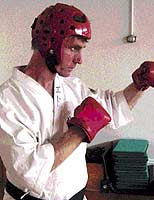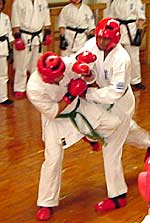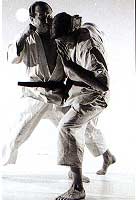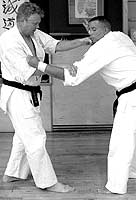For The Sake Of Safety:
Hand Sparring Gear And The Loss Of Hand Techniques
By Christopher Caile

Protective equipment on the hands and feet during sparring in karate,
taekwondo and in many kung fu styles has it increased safety, but have
they also created a new set of problems?
 |
With safety equipment grabbing,
pulling in, catching an arm and some blocks, such as a wrist blocks
have all been eliminated. With thick glove padding hand techniques
are now only blunt instrument hits that emphasis power.
|
Using safety equipment during sparring has affected a
lot of technique – especially
those of the hand. The palm strike and bent wrist block have all but
disappeared, and grabbing has been virtually eliminated too. Furthermore
the knuckles have become so padded in foam or other material that they
have become solely instruments of blunt power attacks. In short, is
safety equipment turning karate into a power punch and kick art?
Of course sparring was always regulated in the name of safety. Targets
were limited and certain techniques were not allowed such as elbow and
knee strikes, attacks to the neck, spine or eyes, etc. In many styles
the legs were off bounds too. But still, participants had some freedom
to utilize many of the grabbing, trapping, sweeping and other techniques – those
same techniques found in kata, and which help define the art form.
Before safety equipment was adopted sparring often involved grabbing
another at the chest or shoulder and pulling in, pushing, or grabbing
an arm to control it or effect a sweep. The variety of techniques was
much greater than found today. Since in many karate, taekwondo and kung
fu schools sparring is virtually the only person on person fighting practice
people get, this reduction in technique can prove to be a limitation.
 |
 |
Without safety equipment
sparring used to be much more rough and tumble with fighters exercising
many grabbing and catching techniques. At left Mas Oyama is seen
catching this author's neck to pull in for a punch during sparring
during a photo session for his book, "This Is Karate" (1961
in Tokyo). This type of technique directly translates into self-defense.
At right this author demonstrates a self-defense technique against
a grab and punch attack (Seido Karate Honbu Seminar 1992). |
So, what happens on the street, if and when the martial
artist comes face to face with a real threat? Well, the many knife/spear
hand attacks,
grabs, off-balances, elbows, knees, head butts, groin and kidney strikes
and pressure point techniques found in kata, just aren’t practiced.
Without practice they become irrelevant, something the mind might be
aware of, but not trained into the instinctive and reactive muscle
memory of the body. And what has been trained within sparring is further
reduced
by the limitations imposed by protective equipment.
Remember the original purpose of karate and kung fu was self-defense.
This is not to say that sparring should not be safe, or that safety equipment
should not be used. But, it does suggest that students should also practice
real street self-defense and that effective techniques should not be
eliminated just because they don’t belong in sparring.
How many advanced, highly ranked martial artists do you know who would
have no idea how to react if someone grabbed their hair and pulled them
(hard) forward and down? I can tell you that in self-defense seminar
after seminar, those I have tested have been totally befuddled by this
and a variety of other street type attacks.
This is not to say that sparring and competition can be very important.
They provide valuable experience in one-on-one simulated combat, build
confidence and develop coordination, skill and a sense of timing. Safety
equipment can also help avoid injury and this is a plus.
But sparring and safety in sparring (use of protective equipment) should
not be over emphasized at the expense of kata (with applications) and
realistic self-defense training. To be prepared for the street, the martial
artist should be trained in defensive and counter techniques and tactics,
done without protective equipment, and under supervision.
The more realistic the attack and defense, the more the participants
will actually be prepared of a real life assault. This will produce more
well rounded karate, taekwondo or kung fu practitioner, one who just
might thank his teacher if he is ever actually attacked on the street.
About The Author:
Christopher Caile is the Founder and Editor-In-Chief of
FightingArts.com. He has been a student of the martial arts for over
43 years. He first started in judo. Then he added karate as a student
of Phil Koeppel in 1959. Caile introduced karate to Finland in 1960 and
then hitch-hiked eastward. In Japan (1961) he studied under Mas Oyama
and later in the US became a Kyokushinkai Branch Chief. In 1976 he followed
Kaicho Tadashi Nakamura when he formed Seido karate and is now a 6th
degree black belt in that organization's honbu dojo. Other experience
includes judo, aikido, diato-ryu, kenjutsu, kobudo, Shinto Muso-ryu jodo,
boxing and several Chinese fighting arts including Praying mantis, Pak
Mei (White Eyebrow) and shuai chiao. He is also a student of Zen. A long-term
student of one branch of Traditional Chinese Medicine, Qigong, he is
a personal disciple of the qi gong master and teacher of acupuncture
Dr. Zaiwen Shen (M.D., Ph.D.) and is Vice-President of the DS International
Chi Medicine Association. He holds an M.A. in International Relations
from American University in Washington D.C. and has traveled extensively
through South and Southeast Asia. He frequently returns to Japan and
Okinawa to continue his studies in the martial arts, their history and
tradition. In his professional life he has been a businessman, newspaper
journalist, inventor and entrepreneur.
|